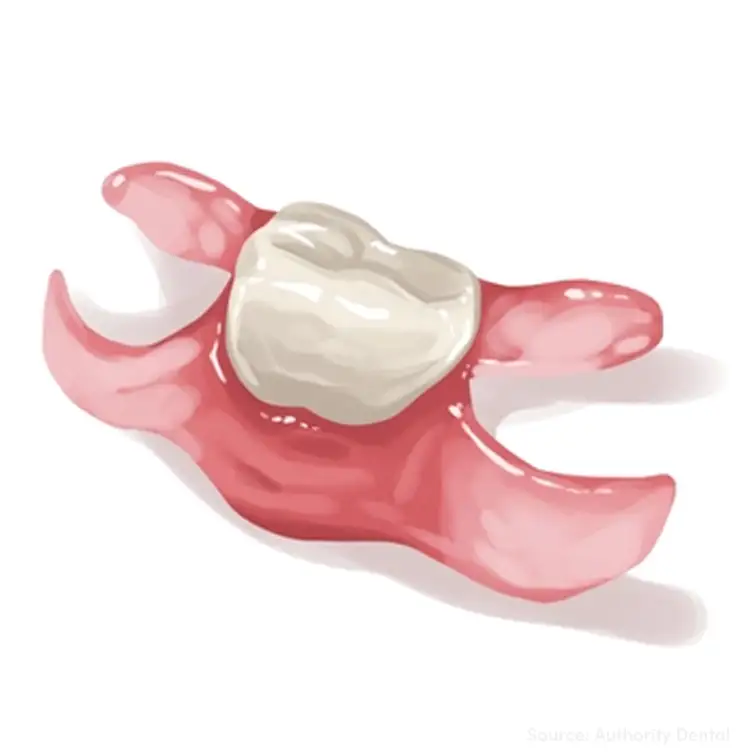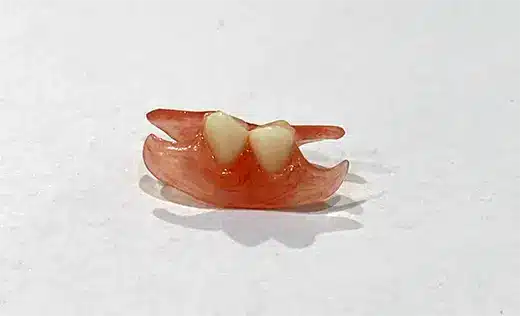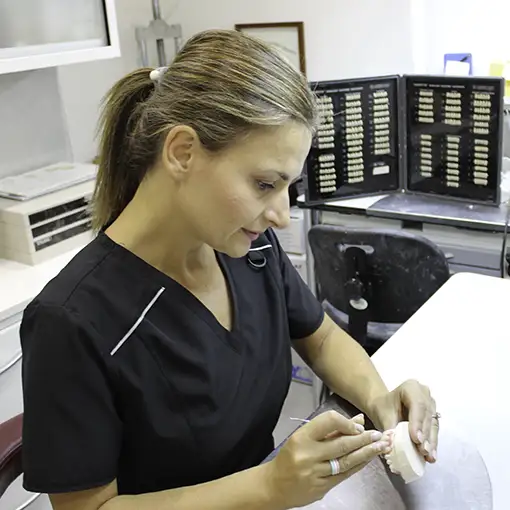

Are you missing one or more teeth and looking for a temporary tooth replacement option? If so, you may want to consider a solution known as a dental flipper tooth. In this article, I'll explain what a dental flipper tooth is and how it works. I'll also cover the benefits and drawbacks of using a dental flipper as temporary solution for missing teeth.
A dental flipper, also known as a dental flipper tooth, is a type of temporary denture. It's most common use case is to act as a short-term replacement tooth following an unexpected tooth loss. In such cases, a flipper is used as a short-term solution for patients waiting for a permanent tooth replacement such as a dental implant or traditional dentures. One of the most common use cases is to act as a temporary restoration option after a sudden tooth loss or emergency extraction. In other words, a dental flipper is a quick, convenient and affordable way to cover a gap in your smile if you've recently or unexpectedly lost a tooth.

A dental flipper is removable prosthetic that can be ready to use within a hour of your tooth loss! Made from acrylic or metal, dental flippers are made with clasps that can be used to connect the flipper to your natural teeth. Because the flipper is a detachable prosthetic, it can be used until a more permanent solution is ready. Like dentures, the shape and colour of the dental flipper can be custom designed by your denturist to match the shape and colour of your natural teeth.
One of the top advantages of a dental flipper is convenience. A flipper can can typically be made in an hour. Another important advantage is that they are generally affordable for patients who need to urgently replace a lost a tooth.
Nevertheless, there are certain disadvantages associated with dental flippers which we've summarized here:
The two most common types of flipper teeth are made from either an acrylic or metal.
Nearly all patients are eligible for a flipper tooth. To be sure, you'll need to book a consultation with an experienced Denturist. During the consultation, your Denturist will evaluate the condition of your adjacent teeth. If these teeth are healthy and strong enough to support a flipper, then you are a good candidate.
After determining your eligibility for dental flipper treatment, the next step involves taking an impression of your mouth. The impression is used by your Denturist to create a solid mold of your mouth similar to what is pictured here. This mold acts like a frame upon which your Denturist can precisely size and position your dental flipper.
The cost of a dental flipper tooth can vary depending on various factors including the number of missing teeth, the complexity of the case, and the location of the dental professional. In Toronto, the average cost of a flipper tooth typically ranges from $350 to $700 per tooth.
It is important to note that a dental flipper is not a permanent solution and may need periodic adjustments or replacement over time. However, it provides an affordable alternative to permanent options and can help restore the appearance of your smile while waiting for a more long-term solution.
Post treatment, many patients find their dental flipper provides a functional solution for their missing teeth. As mentioned earlier, some patients may experience mild discomfort and brief difficulty adapting to the prosthetic. Typically, that may include some soreness or irritation in the gum tissue where the flipper rests. Additionally, there may be some difficulty with speaking or eating initially. After a few days, most patients adapt just fine.
To care for a dental flipper, it is important to follow a few simple guidelines. Firstly, it is recommended to remove the flipper before going to bed and to soak it in a glass of warm water or a denture cleaner. This helps to keep the appliance clean and free from any food particles or plaque. Secondly, when cleaning the flipper, avoid using toothpaste or harsh chemicals as these can damage the appliance. Instead, use a soft-bristle toothbrush with a mild dishwashing liquid or a denture brush specifically designed for cleaning dentures.
In addition to daily cleaning, it is important to visit a dental professional regularly for periodic adjustments and to ensure proper fit and functionality. This is particularly necessary if any changes occur in the mouth, such as gum recession or tooth decay. By following these care and maintenance practices, patients can help prolong the lifespan of their dental flipper and maintain optimal oral health.
Yes, if your insurance plan covers dentures, then it will also cover the cost of a dental flipper.
Yes, dental flipper teeth can be made to look quite natural. Your denturist can customize your flipper to match the shape, size, and colour of the surrounding natural teeth.
A flipper is a temporary oral appliance. It should not be used as a permanent solution due to its low-stability design.
A partial denture is a permanent oral appliance. It is an ideal solution for patients missing several adjacent teeth on the top or bottom arch.
Yes, you’ll be able to chew food properly. Generally speaking the flipper will not move or come loose eating most foods. Additionally, you will not need to worry about biting down to hard on certain foods like apples or meat.
It's possible but not recommended. Ideally, patients should remove their flipper at night. This will allow the gums to breathe and recover from the pressure exerted on the gums during the day.
This depends on the patient. Most patients can wear their flipper the same day as their extraction while other patients may need a day or two for the tissue around the extraction site to recover.
Yes, a single-tooth flipper is a very common solution for patients needing a temporary solution for tooth loss.

Need a same-day dental flipper? No problem! We make same-day dental flippers from our on-site denture lab located at 288 Danforth Avenue.
Note: For same-day service, it's important to book an appointment as early as possible.

WE ACCEPT CDCP COVERAGE
ALL INSURANCE PLANS ACCEPTED
FLEXIBLE PAYMENT PLANS AVAILABLE